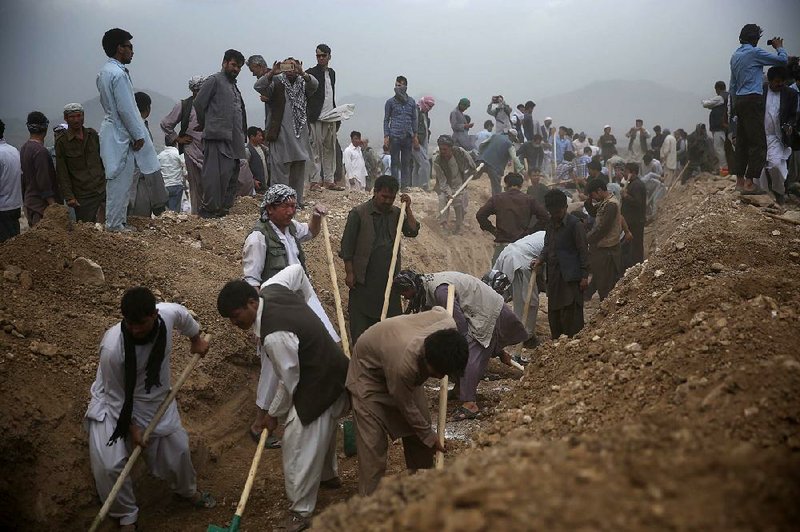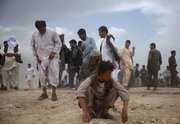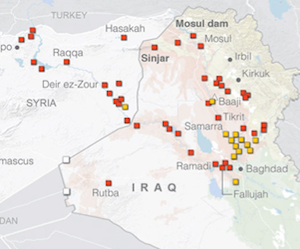KABUL, Afghanistan -- After two years of heavy casualties, the Afghan military is trying to retake the initiative in the war against militants with an offensive against Islamic State loyalists, an assault that will see American troops back on the battlefield working more closely with Afghan soldiers.
Afghan President Ashraf Ghani recently announced a major assault against fighters loyal to the Islamic State militant group who over the past year have captured positions along Afghanistan's eastern border with Pakistan, mainly in Nangarhar province. The goal to uproot the Islamic State from Afghanistan has taken on new urgency in the wake of a suicide bombing Saturday in Kabul that killed at least 80 people.
The Islamic State through its Aamaq online news agency claimed responsibility for the attack, its first in the Afghan capital and one of the deadliest ever to hit Kabul. Ghani, in a live televised address after the bombing, told the nation, "I promise you I will take revenge against the culprits."
Afghanistan on Sunday marked a national day of mourning.
Authorities say 231 people were wounded, some seriously, in the bombing Saturday afternoon during a protest march by members of the ethnic Hazara community, who are predominantly Shiite Muslim. Most Afghans are Sunni, and the Islamic State regards Shiites as apostates.
Bereaved families collected bodies from hospitals and morgues across the capital and began digging graves.
Many people chose to bury their dead along with others -- rather than in traditional family plots -- encouraged by organizers of the Saturday demonstration, who call themselves the Enlighten Movement. In a hilltop graveyard in the Surkh Abad suburb of Kabul, hundreds of people, most of them men, braved high winds and swirling dust to conduct the Shiite funeral rites.
In the city's west, in Omaid-a-Sabz, the grieving chose to bury their dead side by side in long rows.
The inexperienced Afghan forces have largely stalled in the fight against Islamic militants since most international combat troops withdrew in 2014. American forces that remained shifted to a supporting role and U.S. airstrikes diminished, letting the Afghan military take the lead in carrying out the war.
Taliban forces have dominated the battlefield and the Islamic State has been gaining a foothold -- and that has meant mounting losses for Afghan troops. Casualty numbers are not officially released, but according to figures provided by military officials, at least 5,000 troops were killed in 2014 and more than 6,000 died last year. In 2016, Afghan troop deaths are 20 percent higher than at the same point last year.
In an acknowledgment of the deteriorating security situation, President Barack Obama last month gave a green light to a more assertive role for U.S. troops, though that doesn't include direct combat. With that boost, Afghans are shifting back on the offensive.
For the anti-Islamic State operation announced by Ghani, the head of U.S. and NATO forces in Afghanistan, Gen. John Nicholson, is expected to implement an aggressive new strategy. U.S. airstrikes in Afghanistan are likely to become more frequent, as the strategy shifts from using airpower to defend U.S. and NATO positions to using it in support of Afghan offensives.
Nangarhar is one of Afghanistan's most economically important provinces, a major producer of agricultural goods and a thoroughfare for much of the country's exports to Pakistan and beyond.
"It is like a second capital," Afghan army Gen. Shir Mohammad Karimi, the former staff chief of operations, said of the provincial capital, Jalalabad, which is 75 miles east of Kabul.
"It is a gateway to Kabul," he said. "If Nangarhar falls, Kabul will become a battleground every day."
Ghani has said the operation, expected to start before the end of this month, aims to eliminate Islamic State fighters in Nangarhar, where they have been active mainly in the Shinwar, Kot and Achin districts. The Islamic State loyalists are believed to be mostly disaffected Taliban fighters, as well as members of Pakistani insurgent groups, likely funded by Islamic State in Iraq and Syria, Karimi said.
Obama's directives, issued in June, enable the U.S. military to work in a noncombat role alongside Afghan forces on offensive missions against insurgents. Since 2014, the military's role was confined to battles in which the Taliban directly threatened U.S. and NATO forces. The directives also allow U.S. involvement when Afghan forces face "strategic defeat," as they did in the northern city of Kunduz, which briefly fell to the Taliban last September and was threatened again in April.
Obama this month pledged to keep 8,400 troops in the country through 2017, delaying plans to reduce troop numbers to 5,500 by the end of this year. There are currently about 9,800 U.S. troops in the country.
Afghanistan's government and military also received a boost at NATO's summit in Warsaw this month, when the alliance agreed to fund Afghan forces through 2020.
Over the past year, the Taliban have stepped up the fight, deploying more men and weapons than in previous years and expanding to new parts of the country, spreading Afghan forces thin. The Taliban's temporary seizure of Kunduz and several districts unnerved the Afghan population. A Pentagon report to Congress in June said opinion surveys show that perceptions of security have hit "all-time lows" in Afghanistan. In March, 42 percent of those polled said they believe that security is worse than during the time of the Taliban's brutal 1996-2001 rule.
In the past 18 months, Afghan military morale has dropped because of a burgeoning belief that the Taliban are stronger, and corruption and desertion rates among government forces is rising, officials have said.
Still, the militants have not had success in holding territory. And despite heavy fighting early in the year, levels of insurgent violence have been lower than many U.S. military officials had expected to see after the end of the fasting month of Ramadan in early July.
Visiting Afghanistan earlier this month, the chairman of the Joint Chiefs of Staff, Gen. Joseph Dunford, credited the drop in violence to the improved capabilities and "offensive posture" of the Afghan forces. But he said the most intense period of the summer fighting season was only just beginning. Taliban attacks in northern Kunduz province and the neighboring Badakhshan province in the past week could mark the start of a new uptick.
Afghan military affairs analyst Jawed Kohistani said the comparatively subdued levels of Taliban activity were due to internal leadership squabbles after the killing of leader Mullah Akhtar Mansour in a U.S. drone strike in May. His replacement, the conservative cleric Haibatullah Akhundzada, is seen as a weak leader with limited access to funding. The Taliban's strategy under Akhundzada has not yet become clear.
One senior Western diplomat said the summer battle is not likely to be as ferocious as in 2015 because of the increase in U.S. involvement. He spoke on condition of anonymity because he was not authorized to speak publicly on the issue.
According to the Western diplomat, the aim of the Afghan forces' more aggressive stance is to convince the Taliban that they cannot win but should instead join a reconciliation process, beginning with direct contact with the Afghan government, possibly as early as this fall.
Information for this article was contributed by Rahim Faiez and Karim Sharifi of The Associated Press.
A Section on 07/25/2016


